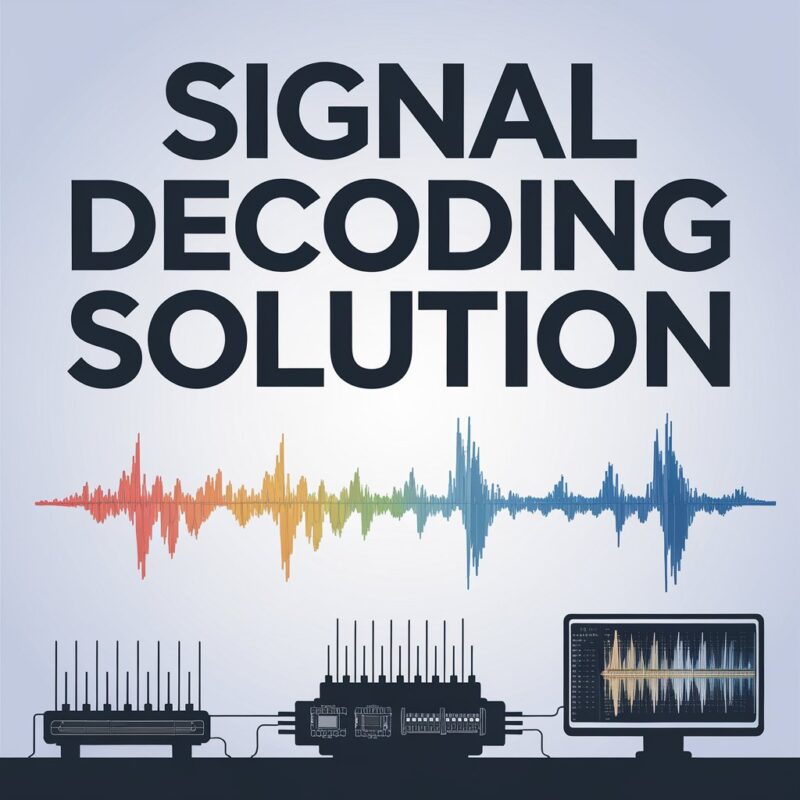Signal decoding solutions are pivotal in ensuring that communication and data transfer remain accurate, secure, and reliable. Whether it’s telecommunications, automotive, or medical sectors, it is integral for processing and interpreting various types of data.
Here, we explore the ten best solutions for different industries, shedding light on how each of these solutions is utilized and why they stand out in their specific fields.
1. Telecommunication

The telecommunication industry heavily relies on efficient processes for uninterrupted service and clear communication channels. Solutions such as Frequency Shift Keying (FSK) and Quadrature Amplitude Modulation (QAM) are frequently employed. FSK is widely used in applications like caller ID systems, remote metering, and various control systems. Also, it requires a proper digital signal decoder software.
On the other hand, QAM is vital for enhancing bandwidth efficiency in communication systems, offering higher data rates in limited bandwidth environments.
2. Automotive
The automotive industry utilizes solutions to interpret data from various sensors and communication protocols like Controller Area Network (CAN). CAN decoders play a significant role in modern vehicles by allowing them to transmit real-time information essential for efficient monitoring and diagnostics. These decoders help in translating signals related to speed, fuel consumption, engine performance, and other critical metrics. In today’s vehicles, these solutions are also crucial in enhancing safety features by processing data from sensors used for automatic braking, lane assistance, and collision detection systems.
3. Medical Device

Medical devices rely on precise signal decoding for real-time monitoring and diagnostics. Solutions used in devices like Electrocardiogram (ECG) and Electroencephalogram (EEG) machines decode bioelectrical signals, providing accurate readings for patient monitoring and diagnosis. Advanced decoding algorithms help medical professionals interpret the signals, offering insights into heart conditions, brain activity, and other physiological functions. For instance, ECG decoders analyze electrical impulses from the heart, enabling early detection of arrhythmias or other heart conditions. Similarly, EEG decoders play a crucial role in diagnosing neurological disorders by translating brain wave patterns into readable data.
4. Aerospace

In the aerospace industry, signal decoding is essential for communication, navigation, and safety. Aerospace systems employ solutions such as Differential Phase Shift Keying (DPSK) and Pulse Code Modulation (PCM) to decode signals from satellites, ground control stations, and onboard instruments. These systems translate signals into actionable data for guiding aircraft, ensuring precise navigation, and managing communication between different systems. Whether it’s GPS for positioning or radar for detecting obstacles and other aircraft, these solutions are key to ensuring safety and operational efficiency in aerospace.
5. Industrial Automation
The industrial sector heavily relies on options for automating machinery and equipment. Decoding solutions like Pulse Width Modulation (PWM) and Frequency Modulation (FM) are used in controlling motors, sensors, and actuators. PWM decoders are widely applied in adjusting the speed of conveyor belts, robotic arms, and other automated systems, while FM ensures stable signal transmission for remote equipment control. By decoding signals accurately, industries achieve higher precision and control in automated systems, leading to improved productivity and efficiency.
6. Broadcast and Media
In the broadcast and media industry, signal decoding solutions are essential for delivering clear audio and video content. Solutions like MPEG and Phase Alternating Line (PAL) decoding are commonly employed in television and radio broadcasting. MPEG decoding ensures high-quality video compression and transmission, supporting the delivery of content across various platforms without compromising quality. PAL decoders, on the other hand, maintain consistent color signals and visual fidelity in broadcast content, especially in regions where PAL is the standard. Proper signal decoding allows broadcasters to transmit uninterrupted, high-quality content, ensuring a smooth viewer experience. Additionally, the rapid growth of streaming services and digital media distribution has increased the demand for reliable decoding solutions capable of handling high-definition and ultra-high-definition content.
7. Defense and Military
Signal decoding is a crucial component of communication, surveillance, and intelligence operations in defense and military applications. Solutions such as Spread Spectrum and Frequency Hopping are commonly used to ensure secure and resilient communication. Spread Spectrum decoders help in minimizing interference and making communications difficult to intercept, providing a layer of security that is vital in hostile environments. Frequency Hopping, on the other hand, dynamically changes frequencies during transmission, making it even harder for adversaries to jam or intercept communications. Military applications depend on these advanced decoding systems for strategic communication, secure data transmission, and enhanced situational awareness. In addition to communication, signal decoding solutions also play a role in decoding radar and sonar signals, which are essential for reconnaissance, target detection, and threat assessment.
8. Financial Trading
In the financial industry, signal decoding solutions contribute significantly to real-time trading, market analysis, and decision-making processes. Advanced algorithms such as Fourier Transform and Wavelet Transform are used to decode complex market signals, helping traders make informed decisions based on accurate data. These decoding systems translate high-frequency trading signals and market indicators into actionable insights, enabling faster and more accurate trades. Additionally, signal decoding solutions are essential in detecting fraudulent activities by analyzing irregular patterns in trading signals, helping financial institutions protect against cyber threats and market manipulation.
9. Energy Sector
The energy sector, particularly in the management of renewable energy sources, relies on signal decoding for monitoring and control. Power Line Communication (PLC) decoding is widely used for transmitting data over electrical lines, enabling efficient management of power distribution systems and grid operations. These decoding systems interpret signals for real-time monitoring of energy consumption, grid performance, and fault detection, contributing to better resource management and operational efficiency. In the renewable energy segment, signal decoding solutions are integral for optimizing the performance of solar panels, wind turbines, and other energy-generating equipment by interpreting sensor data and environmental conditions.
10. Consumer Electronics

Consumer electronics, including smartphones, smart TVs, and IoT devices, rely heavily on signal decoding for functionality and user experience. Solutions like Bluetooth decoding and Infrared (IR) decoding are used to process signals for device connectivity, control, and communication. Bluetooth decoders, for instance, translate wireless signals for seamless interaction between devices, enabling features like file transfer, audio streaming, and device pairing. IR decoders, commonly found in remote controls, translate signals to control televisions, air conditioners, and other appliances. In the rapidly expanding IoT ecosystem, signal decoding solutions are also crucial for managing smart home devices, wearable technology, and connected appliances.
Conclusion
Signal decoding solutions are indispensable across various industries, ensuring reliable communication, accurate data interpretation, and operational efficiency. From telecommunication and automotive to medical and industrial automation, each industry relies on specific decoding technologies tailored to its unique needs. Understanding the right signal decoding solution for each application is critical for optimizing performance and achieving desired outcomes in today’s data-driven world.
Related Posts:
- 5 Different Types of Access Solutions - 2024 Guide
- Different casino attires for different occasions -…
- 7 Industries Revolutionized by Technological Innovations
- 7 Tips How to Improve Weak TV Signal in Your Home 2024
- 10 Best X470 Motherboards 2024 - for Better Audio Solutions
- 6 Different Ways to Consume CBD And Which One is The Best?








